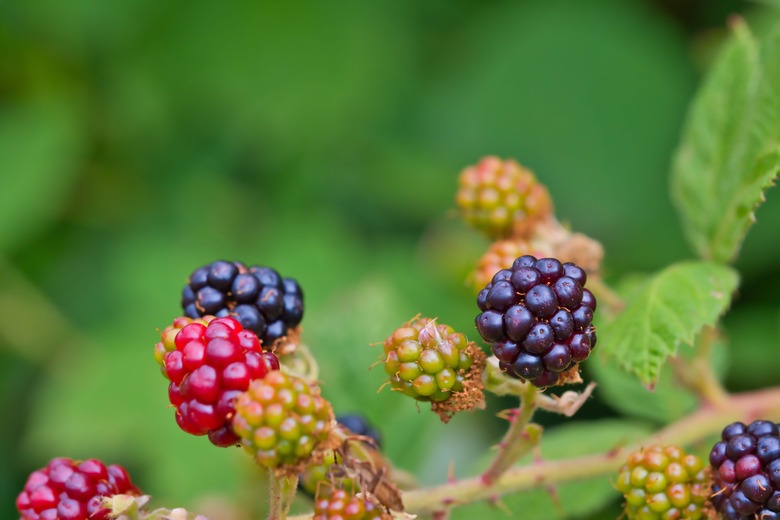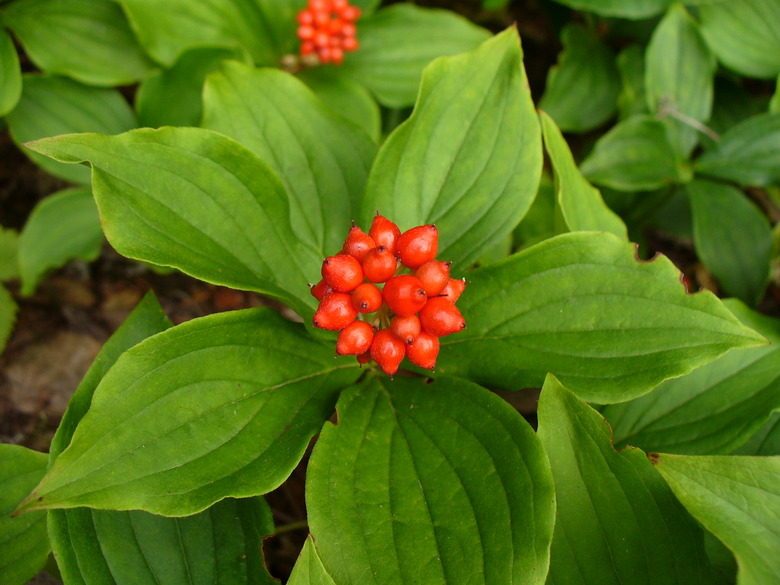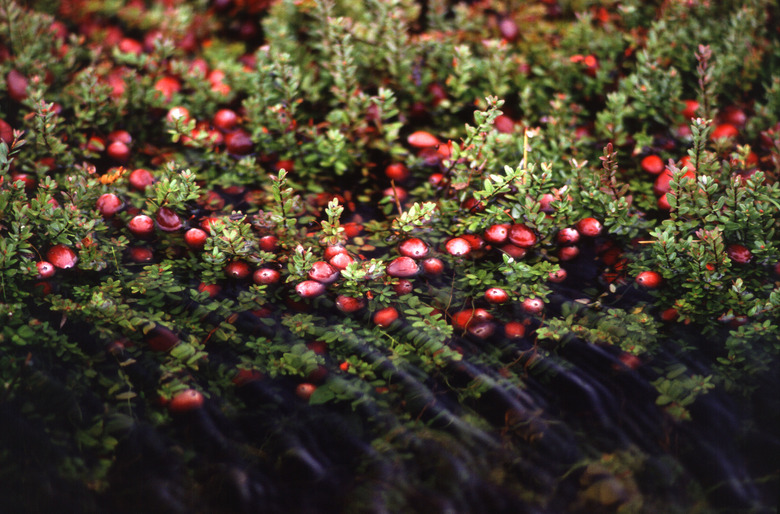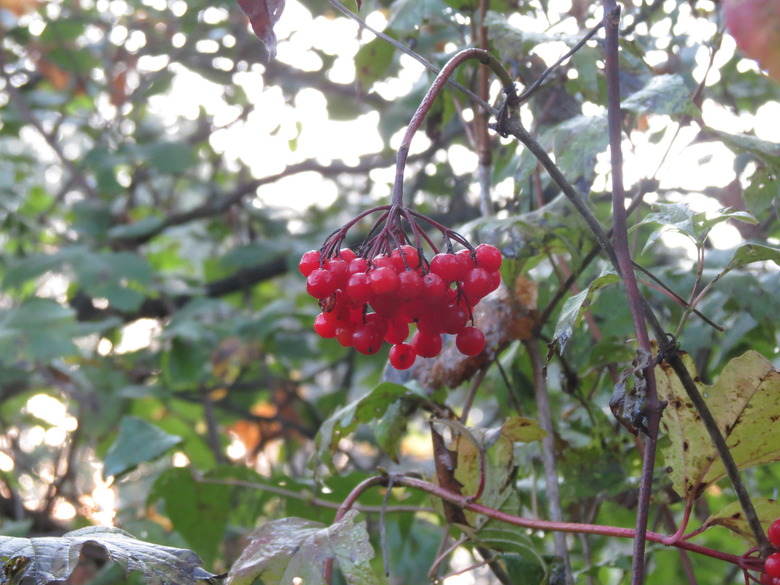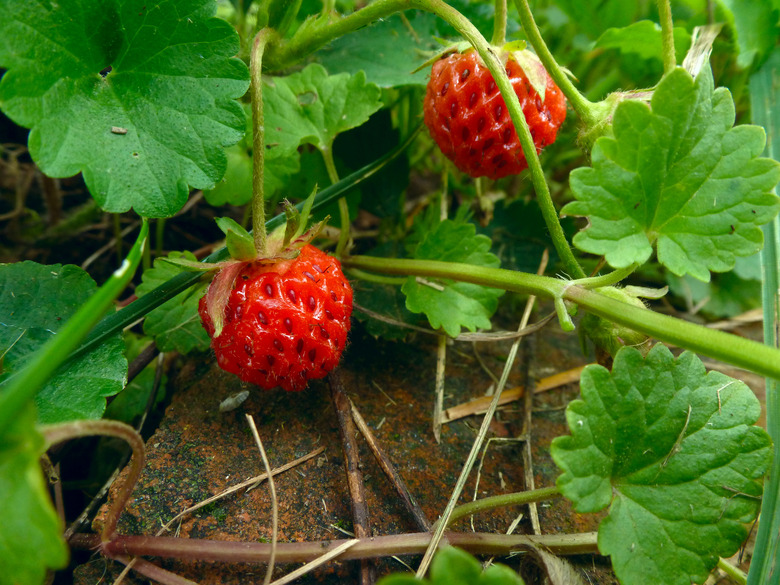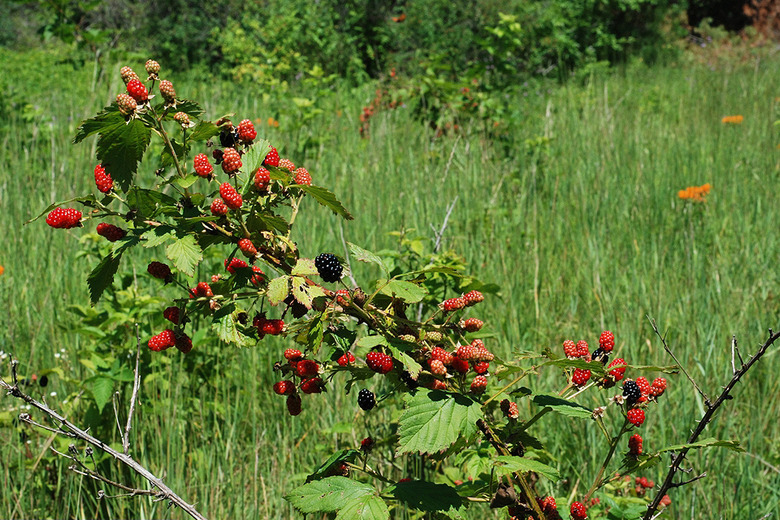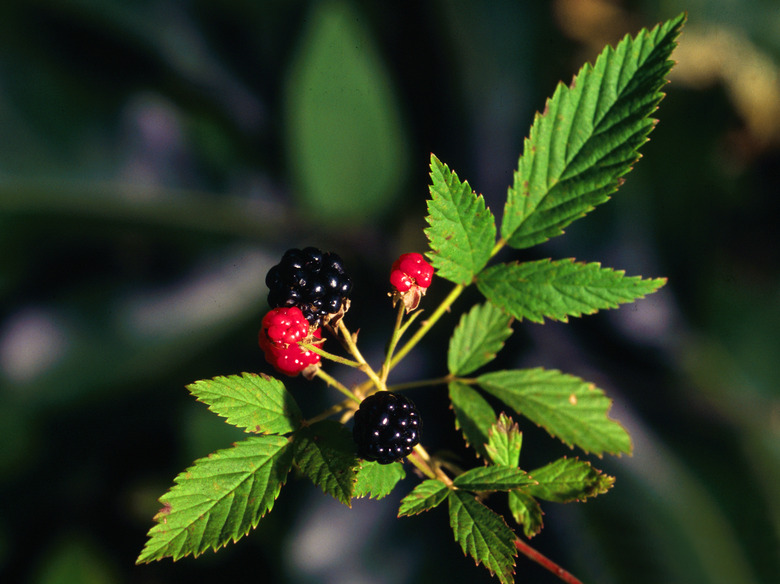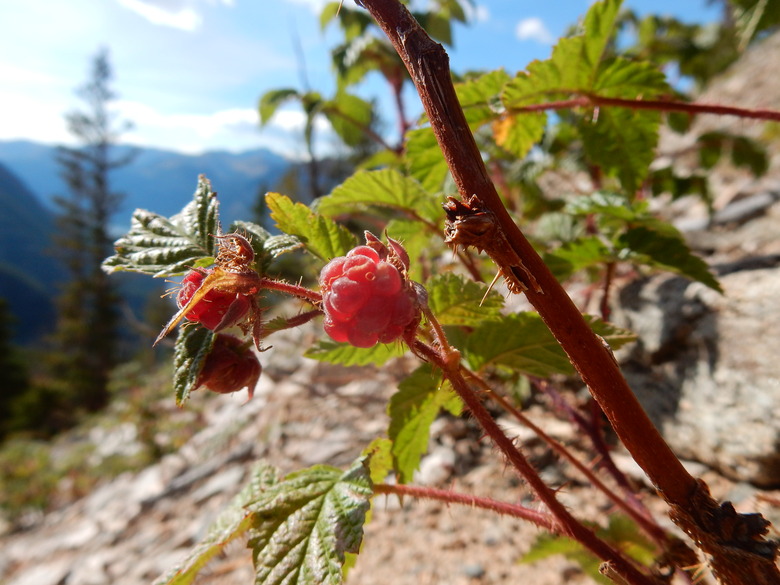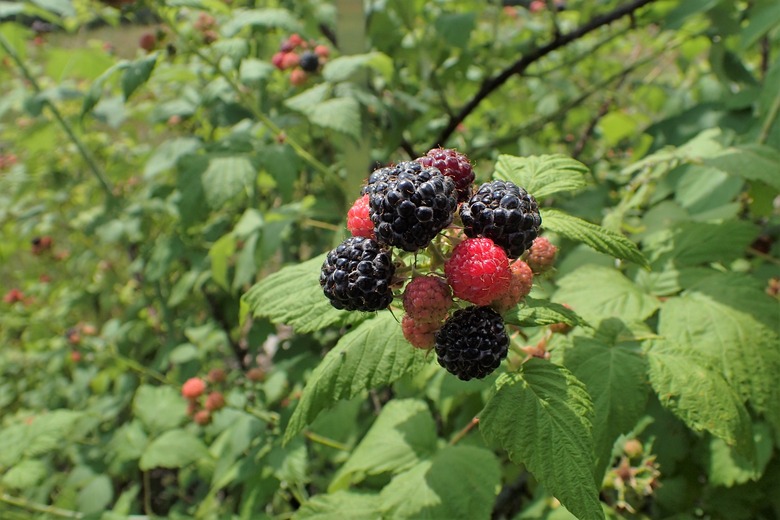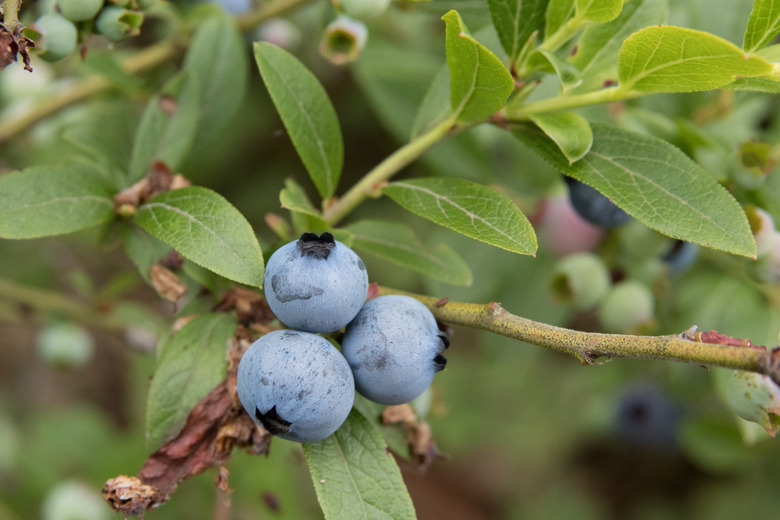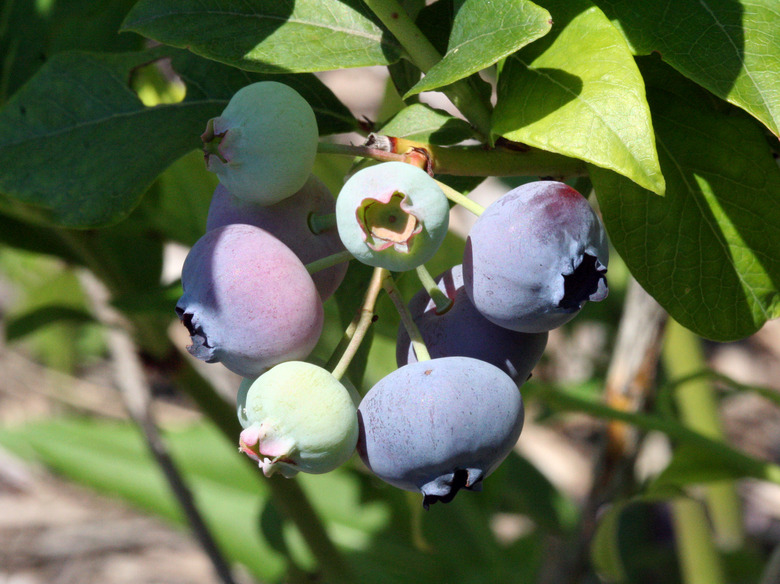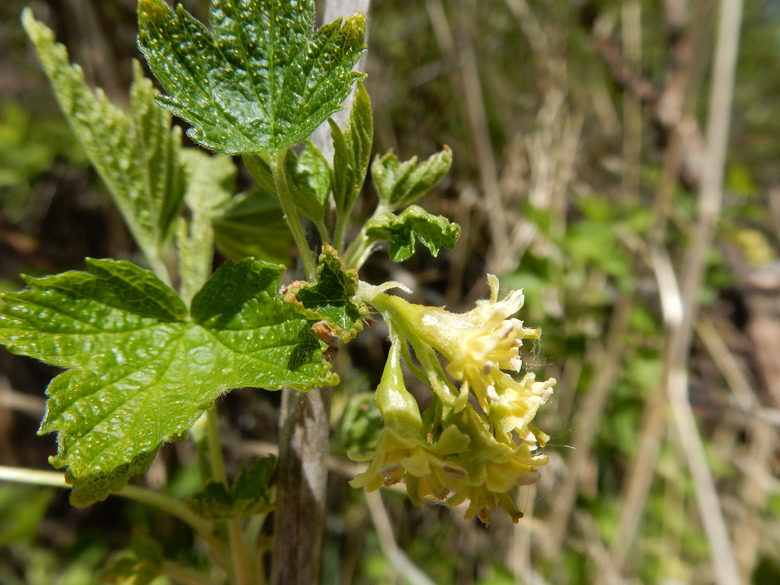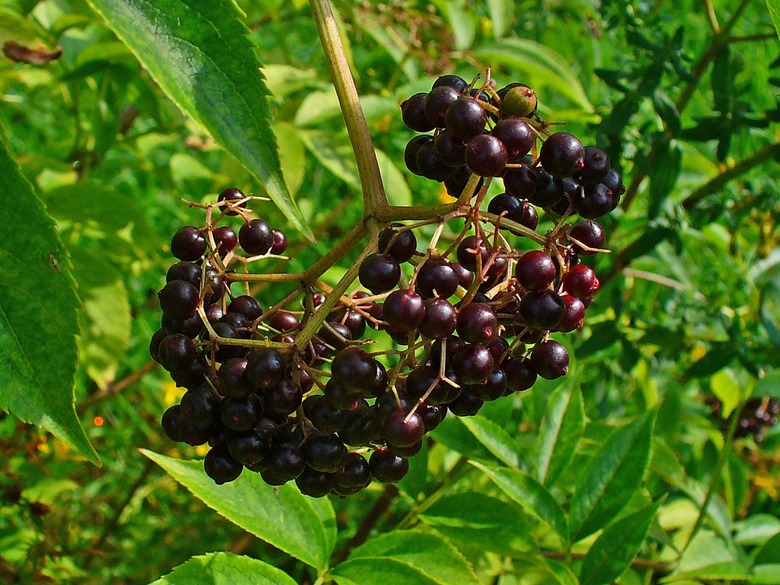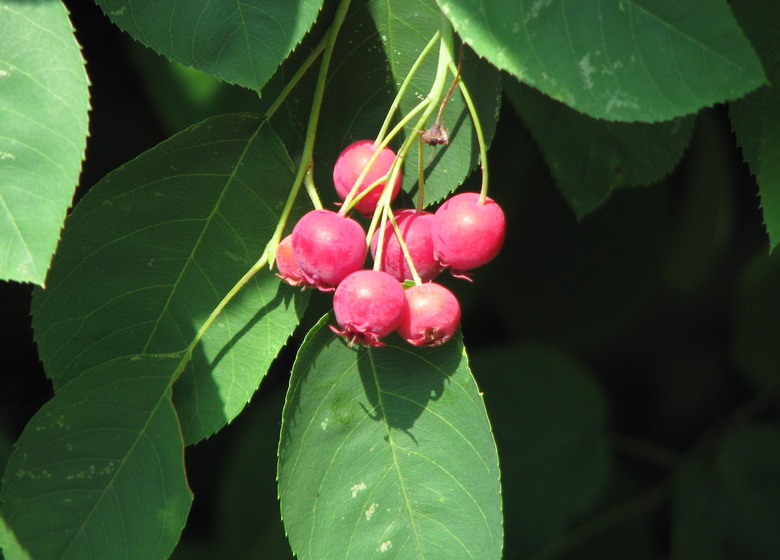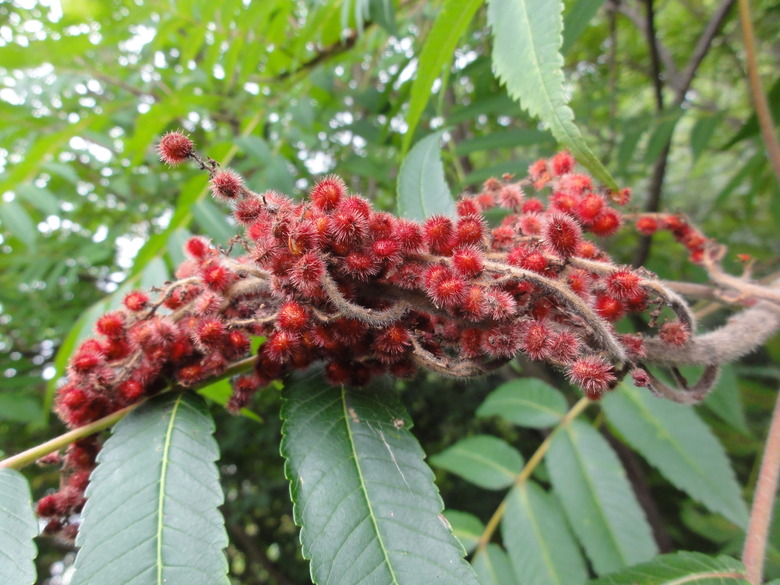How To Identify Michigan Wild Berry Plants
The edible wild fruits of Michigan include favorites like blackberries and raspberries as well as a variety of other fruiting plants, ranging from low-growing wild strawberries to serviceberry trees.
Whether harvesting berries or taking cuttings to grow your own in the garden, it's best to identify the plants before preparing and enjoying the tasty fruits. The plant's size, flowers, leaves and berries are all identifying elements that ensure it is the correct fruiting species.
Use Caution When Harvesting Berries
When you're uncertain whether a berry is edible, don't use wildlife as an example. Humans can't always tolerate the same potentially toxic compounds as birds, deer, rabbits or bears.
In addition to carrying an illustrated guide to Michigan wild berry plant identification, follow the "berry rule"—**only about 10 percent of white or yellow berries and 50 percent of red berries are safe to eat. Approximately 90 percent of blue, purple or black berries are safe, while nearly all of the aggregated berries, like blackberries and raspberries, are edible.**
In addition to correctly identifying wild berries, some fruits are best enjoyed after cooking. While dewberries are extremely sour, they make delicious preserves. On the other hand, elderberries are toxic when raw but a treat when made into pies or when heated and processed into syrup, jellies and jams, juice or wine.
Perennial Berry Plants
There are a few low-growing fruiting perennials that produce berries. While edible, some are not particularly tasty. Others are native species that are closely related to the tasty hybridized fruits available in stores, such as strawberries.
Bright Red Bunchberries
The bunchberry (Cornus canadensis) is low-growing shrubby perennial. A dwarf dogwood species, it spreads by rhizomes. It prefers moist, acidic soils in partial, dappled and full shade.
While the bright red berries are edible, they are bland and mealy and may cause an upset stomach. In addition, members of the dogwood family may cause skin irritation in sensitive individuals.
- **Scientific Name:** Cornus canadensis
- **Common Names:** Creeping dogwood, dwarf cornel
- **Type:** Deciduous creeping ground cover
- **Size:** 4 to 12 inches tall and 6 to 12 inches wide
- **Flowers:** Four 1-inch-long, oval white bracts surrounding a greenish-yellow center
- **Berries:** Bright red and 1/4-inch diameter
- **Leaves:** 1- to 2-inch-long glossy medium to dark green leaves that are red to purple in fall
- **USDA Zones:** 2 to 6
Cranberries: Two American Species
There are two native American cranberry species that share the common name "American cranberry." The familiar large cranberries (Vaccinium macrocarpon) found as a tasty treat on the holiday table are produced on a low-growing woody vine or trailing shrub.
It grows in full sun and partial shade in soils that are well drained, moist, organically rich and acidic. The tart red berries are best when cooked and processed into sauces or jams and jellies or when dried for snacking or baking.
- **Scientific Name:** Vaccinium macrocarpon
- **Common Names:** American cranberry, bearberry, cranberry, large cranberry
- **Type:** Evergreen woody vine or trailing shrub
- **Size:** 12 to 36 inches tall and 1 to 6 feet wide
- **Flowers:** 1-inch-wide; four thin bright pink or white petals
- **Berries:** Red to dark purple; 1/2-inch diameter
- **Leaves:** Less than 1-inch-long oval leaves
- **USDA Zones:** 3 to 7
Also known as American cranberry, the highbush cranberry (Viburnum opulus var. americanum) is a decorative shrub with edible red berries.
This deciduous shrub thrives in full sun and partial shade in well-drained, moist soils. It also tolerates wet and alkaline soils. The fruits can be made into jellies and jams, preserves, sauces and juice.
- **Scientific Name:** Viburnum opulus var. americanum or Viburnum trilobum
- **Common Names:** American cranberry bush, American cranberrybush, American viburnum, dog elder, dog rowan, highbush cranberry, ople tree, snowball tree
- **Type:** Deciduous shrub
- **Size:** 8 to 12 feet tall and wide
- **Flowers:** White, 3-inch-wide lacetop clusters surrounding a center of tiny, fertile flowers
- **Berries:** Bright red; 1/3-inch diameter
- **Leaves:** Maple-shaped, 2- to 4-inch-long dark green leaves that turn reddish-purple in fall
- **USDA Zones:** 2 to 7
Warning
The European highbush cranberry species (Viburnum opulus) is a similar shrub, but the berries have large seeds, and while technically edible, they are acidic and bitter. When purchasing a highbush cranberry, avoid the European species, as it is considered invasive. It has escaped captivity and naturalized in the Midwestern and Northeastern states and north into Canada.
Native Wild Strawberries
The wild strawberries (Fragaria virginiana) of North America are cool-season fruits that die back in hot summers and rebound in spring and fall. The red fruits are not as sweet as commercially produced strawberries, which are a hybrid of the wild strawberry and South American strawberry (Fragaria chiloensis).
The low-growing wild strawberries spread by runners and can form large colonies in woodlands, meadows and other full-sun to partial-shade locations across Eastern North America.
- **Scientific Name:** Fragaria virginiana
- **Common Names:** Scarlet strawberry, wild strawberry
- **Type:** Low-growing perennial
- **Size:** 4 to 8 inches tall and 12 to 24 inches wide
- **Flowers:** 3/4-inch-wide white flowers in clusters of four to six
- **Berries:** Red; 1/2 inch wide
- **Leaves:** Green, tooth-edged, trifoliate leaf with three 1- to 1 1/2-inch-long leaflets on a 6-inch-tall stalk
- **USDA Zones:** 4 to 9
Warning
Mock strawberries (Duchesnea indica) closely resemble wild strawberries except the five-petal flowers are yellow and the red fruits are essentially flavorless. The berries point up, making them highly visible, while wild strawberry fruits are hidden under the leaves. This plant is considered an invasive weed.
Berries on Brambles
A variety of berries grow on arching and often prickly canes known as brambles. These members of the Rubus genus generally develop into tangled masses of woody vines. While the plants are perennials, the individual canes are biennial, producing flowers and fruit primarily on the second-year growth.
The flowers mature into segmented berries in early summer. Brambles may be found in dry to moist acidic soils in full sun and partial or dappled shade in fields, forests and woodlands.
Wild Blackberries in Michigan
Wild blackberries in Michigan may be native blackberries (Rubus allegheniensis) or escaped North American and European Rubus species and their hybrids.
The native wild blackberry grows into an upright shrub form and then the canes bend to the soil and root to start new plants. The canes feature purple-red bark and numerous prickles.
Wear rose gloves when pruning blackberries to avoid puncture wounds and use caution when harvesting the seedy, sweet berries.
- **Scientific Name:** Rubus allegheniensis
- **Common Names:** Allegheny blackberry, blackberry, common blackberry, dewberry
- **Type:** Deciduous bramble
- **Size:** 4 to 8 feet tall and 4 to 10 feet wide
- **Flowers:** Five-petal white flowers in clusters
- **Berries:** Black or reddish-burgundy aggregate berries; 3/4-inch long and 1/3-inch diameter
- **Leaves:** Rough green leaves with serrated edges; 3 to 6 inches long and 1 to 3 inches wide
- **USDA Zones:** 3 to 8
Low-Growing Dewberries
Unlike the other brambles, dewberry vines (Rubus flagellaris) tend to sprawl across the ground rather than growing into an upright mass of vines. The berries ripen from June through September.
While sour, with plenty of added sugar, dewberries make tasty jams, jellies and preserves.
- **Scientific Name:** Rubus flagellaris
- **Common Names:** America dewberry, common dewberry, northern dewberry
- **Type:** Deciduous bramble
- **Size:** Up to 4 feet tall and 16 1/2 feet wide
- **Flowers:** Five-petal white blossoms in clusters from April to June
- **Berries:** Black, sometimes red
- **Leaves:** Three to five leaflets; serrated; glossy green matures to darker dull green
- **USDA Zones:** 3 to 8
Red and Black Raspberries
Native red raspberries (Rubus idaeus var. strigosus) have an upright growth pattern with canes that arch to the soil and root to form new canes. Like other brambles, red raspberries flower and fruit on second-year canes.
Wild raspberries have sharp prickles on the canes. These brambles may be found in full sun or partial shade in well-drained, acidic soils across most of North America.
- **Scientific Name:** Rubus idaeus var. strigosus
- **Common Names:** American red raspberry, red raspberry
- **Type:** Deciduous, semievergreen bramble
- **Size:** 3 to 6 feet tall and wide
- **Flowers:** Star-shaped; 1 to 3 inches wide; five white, pink or lavender petals
- **Berries:** Red aggregate berries with a hollow core; less than 1 inch long
- **Leaves:** Green; 3 to 6 inches long and 1 to 3 inches wide; prickly compound leaves with three to five leaflets
- **USDA Zones:** 4 to 8
Black raspberries (Rubus occidentalis) are also native to North America. Similar to red raspberries, the fruits are sweet with a little tartness. Black raspberry bushes may be found in moist, organically rich soils in full or partial sun in woodlands and alongside roads.
- **Scientific Name:** Rubus occidentalis
- **Common Names:** Blackberry, blackcap, black raspberry, dewberry
- **Type:** Deciduous bramble
- **Size:** 3 to 6 feet tall and 4 to 8 feet wide
- **Flowers:** Star-shaped; up to 1 inch wide; five white petals
- **Berries:** Black or purplish-black aggregate berries with a hollow core; less than 1 inch long
- **Leaves:** Green; 1 to 3 inches long and wide; compound leaves with three leaflets
- **USDA Zones:** 4 to 8
Shrubs and Trees
There are a wide range of native shrubs and small trees in Michigan. These woody plants produce tasty berries in summer and fall. When harvesting berries, prepare and use them as soon as possible or preserve, freeze or dry them for longer storage.
Blueberries: Two Native Species
The wild blueberries in Michigan are one of two species: the lowbush or highbush species. Lowbush blueberries (Vaccinium angustifolium) are found in acidic, well-drained soils amid open conifer forests, barren sandy or rocky areas or where fires have previously scorched the landscape.
While they grow in partial shade, they produce more flowers and fruits in full sun.
- **Scientific Name:** Vaccinium angustifolium
- **Common Names:** Late lowbush blueberry, low bush blueberry, low sweet blueberry
- **Type:** Deciduous shrub
- **Size:** 6 to 24 inches tall and equally wide
- **Flowers:** Bell-shaped; 3/16-inch white flowers tinged with pink
- **Berries:** Blue; 1/8- to 1/4-inch diameter
- **Leaves:** Finely toothed; 1- to 3-inch-long and up to 1-inch-wide dark green leaves that are reddish-green in spring and reddish-bronze in fall
- **USDA Zones:** 2 to 8
The highbush blueberry (Vaccinium corymbosum) thrives in medium to wet soils and is often found in bogs and swamps. It grows best in acidic, organically rich, well-drained soils in full sun and part or dappled shade.
- **Scientific Name:** Vaccinium corymbosum
- **Common Names:** High-bush blueberry, northern highbush blueberry, rabbiteye blueberry, tall blueberry
- **Type:** Deciduous shrub
- **Size:** 6 to 12 feet tall and 8 to 12 feet wide
- **Flowers:** Clusters of bell-shaped, 3/8-inch white flowers tinged with pink
- **Berries:** Blue; 1/8- to 1/4-inch diameter
- **Leaves:** 1 to 3 inches long and up to 1-inch-wide dark green leaves that are reddish-green in spring and reddish-bronze in fall
- **USDA Zones:** 5 to 8
Wild Black Currents
Native to North America east of the Rockies and mostly north of Tennessee and North Carolina, wild black currents (Ribes americanum) are found in open forests and thickets, in swamps and alongside streams and lakes.
Other Ribes species, all members of the gooseberry family (Grossulariaceae), have the same leaf shapes, though those shrubs' leaves are more strongly scented than black current leaves.
The sour black current berries are usually cooked into jams, compotes and syrups. They are also combined with other fruits in pies and crumbles or are dried for snacking.
- **Scientific Name:** Ribes americanum
- **Common Names:** American black current
- **Type:** Deciduous shrub
- **Size:** 3 to 5 feet tall and wide
- **Flowers:** Clusters of fragrant, bell-shaped yellow blossoms
- **Berries:** Deep purple; 1/3-inch diameter
- **Leaves:** Green; 1 to 2 inches long and wide; three-lobed with serrated edges and a hairy surface
- **USDA Zones:** 3 to 8
American Black Elderberries
The American elderberry (Sambucus canadensis) is known for the soothing syrup made from its berries. In addition to cough syrup, the berries are cooked and used in jams, jellies, pies, elderberry wine and liqueur.
Native to the Eastern states, it is found in moist soils along streams, in woodlands and alongside roads. It prefers full-sun to partial-shade locations.
- **Scientific Name:** Sambucus canadensis or Sambucus nigra ssp. canadensis
- **Common Names:** American black elderberry, American elder, Canada elderberry, common elderberry
- **Type:** Deciduous shrub
- **Size:** 5 to 12 feet tall and wide
- **Flowers:** Edible, lemon-scented white flowers in rounded or flat-topped 10-inch-wide clusters
- **Berries:** Dark purple or black; 1/8 inch wide
- **Leaves:** Bright green 12-inch-long compound leaves composed of five to 11 2- to 6-inch-long leaflets with sawtooth edges
- **USDA Zones:** 3 to 9
Warning
All parts of the elderberry are poisonous. The fruits are safe once cooked; do not eat uncooked berries. In addition, don't confuse elderberries and poisonous pokeweed berries (Phytolacca americana). Pokeweed has large single leaves on green or reddish stems and shiny, 1/4-inch-wide deep purple berries that contain one large seed.
Serviceberries or Juneberries
Serviceberries (Amelanchier spp.) include several shrub-like or small tree species native to Michigan. Tolerant of neutral to acidic soils, serviceberries are found in locations ranging from full sun to full shade.
The blueberry-like fruits ripen in June, leading to the common name "juneberry." Enjoy the berries fresh or in pies, jellies and jams.
- **Scientific Name:** Amelanchier spp.
- **Common Names:** Deerberries, juneberries, saskatoon berries, sugar plums, wild plums
- **Type:** Deciduous shrubs or small trees
- **Size:** 15 to 25 feet tall and wide
- **Flowers:** Drooping clusters of fragrant 3- to 6-inch five-petal white flowers
- **Berries:** Blue; 1/4 to 7/16 inch depending on the species
- **Leaves:** Green rounded, toothed edges; 3 to 6 inches long and 1 to 3 inches wide; changes to yellow-orange and red-orange in fall
- **USDA Zones:** 2 to 9 depending on the species
Staghorn Sumac Berries
The staghorn sumac (Rhus typhina) is a large shrub or small tree native to Eastern North America. While it shares a name with poison sumac (Toxicodendron vernix), it is an entirely different species. Poison sumac has white berries and grows in swampy locations, while staghorn sumac has red berries and prefers dry to medium well-drained soils along roads and woodlands.
Once harvested, staghorn sumac berries are crushed and soaked in water to make a lemony drink. They are also dried, ground and used as a spice rub for chicken, lamb and fish or to season food at the table.
- **Scientific Name:** Rhus typhina
- **Common Names:** Lemonade tree, staghorn sumac
- **Type:** Deciduous shrub or small tree
- **Size:** 15 to 25 feet tall and 20 to 30 feet wide
- **Flowers:** Drooping 8-inch-long clusters of 1/4-inch greenish-yellow flowers
- **Berries:** Bright red berries; 5/32-inch diameter
- **Leaves:** Bright green, 24-inch-long compound leaves with 13 to 27 toothed 2- to 5-inch-long leaflets
- **USDA Zones:** 3 to 8
Warning
Staghorn sumac is in the same plant family as cashews and mangoes. Sensitive individuals should use caution when ingesting staghorn sumac berries.
References
- Michigan Department of Natural Resources: Foraging for Wild Berries
- Missouri Botanical Garden: Cornus canadensis
- Children's Hospital of Philadelphia: Nonpoisonous Berries
- North Carolina Extension Gardener Plant Toolbox: Vaccinium macrocarpon
- North Carolina Extension Gardener Plant Toolbox: Viburnum opulus var. americanum
- Missouri Botanical Garden: Fragaria virginiana
- University of Minnesota Extension: Mock Strawberry
- North Carolina Extension Gardener Plant Toolbox: Rubus allegheniensis
- North Carolina Extension Gardener Plant Toolbox: Rubus idaeus var. strigosus
- North Carolina Extension Gardener Plant Toolbox: Rubus occidentalis
- North Carolina Extension Gardener Plant Toolbox: Vaccinium angustifolium
- Missouri Botanical Garden: Vaccinium corymbosum
- Minnesota Wildflowers: Ribes americanum (Wild Black Currant)
- Missouri Botanical Garden: Sambucus canadensis
- North Carolina Extension Gardener Plant Toolbox: Amelanchier
- City of Ann Arbor Michigan: 10,000 Trees Initiative: Serviceberry (Amelanchier spp.)
- North Carolina Extension Gardener Plant Toolbox: Staghorn Sumac Rhus typhina
